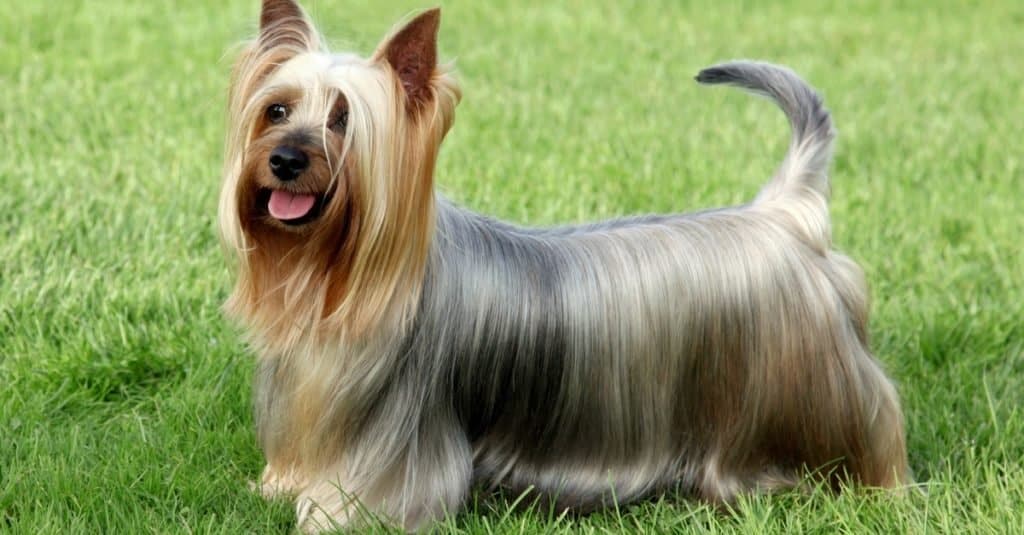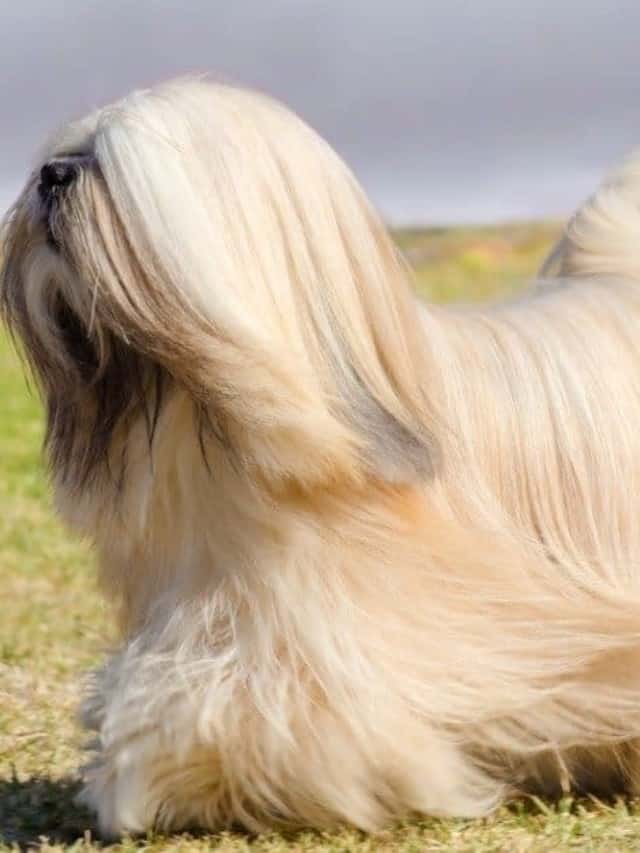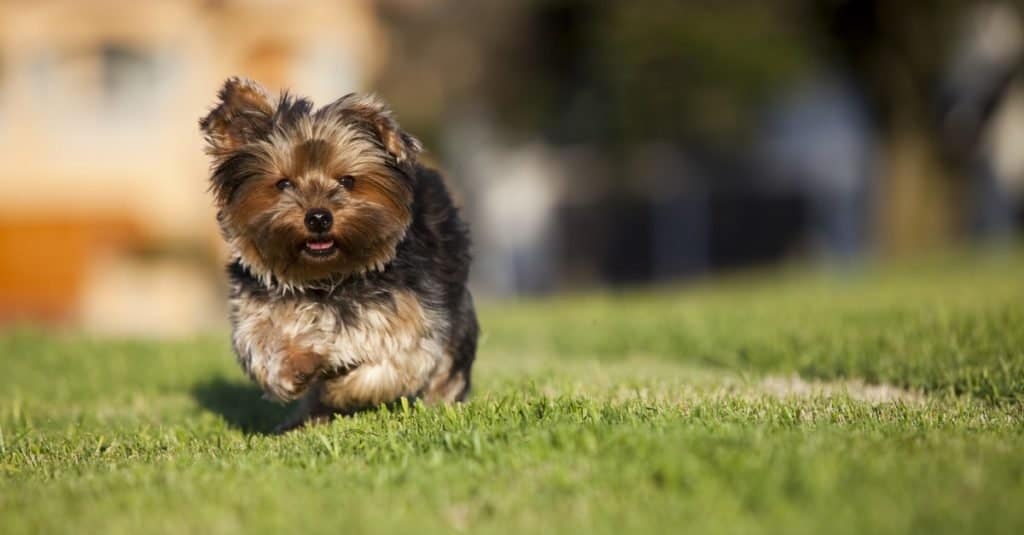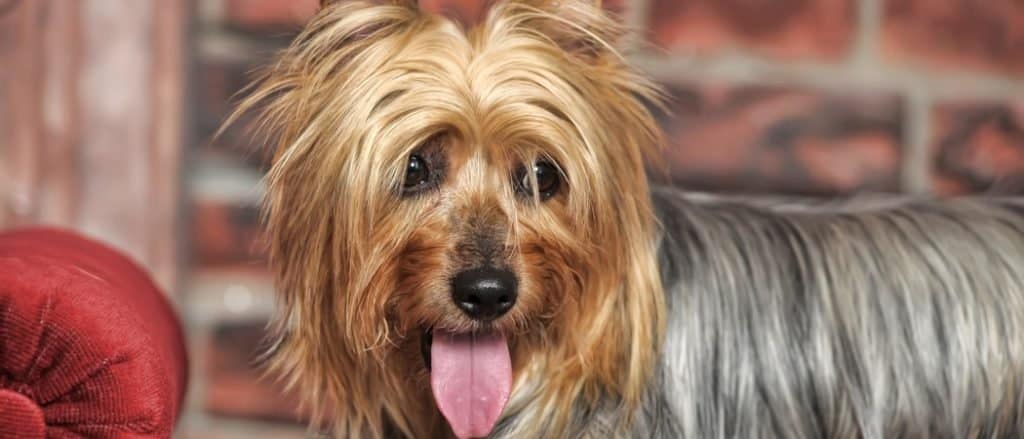Silky Terrier
Canis lupus
Silky terriers can be trained to participate in many events, including herding, agility, rally, tracking and fly ball.
Advertisement
Silky Terrier Scientific Classification
- Kingdom
- Animalia
- Phylum
- Chordata
- Class
- Mammalia
- Order
- Carnivora
- Family
- Canidae
- Genus
- Canis
- Scientific Name
- Canis lupus
Read our Complete Guide to Classification of Animals.
Silky Terrier Conservation Status
Silky Terrier Facts
- Fun Fact
- Silky terriers can be trained to participate in many events, including herding, agility, rally, tracking and fly ball.
- Temperament
- Proud and opinionated
- Diet
- Omnivore
Silky Terrier as a Pet:
- General Health
- Energy Level
- Shedability
- Trainability
- Intelligence
- Tendency to Chew
- Size
- Family and kid friendliness
- Yappiness / Barking
- High
- Hypoallergenic
- Yes
- Separation Anxiety
- High
- Preferred Temperature
- Warm climate
- Exercise Needs
- High
- Friendly With Other Dogs
- Moderate
- Pure bred cost to own
- $1,500
- Dog group
- Toy
- Male weight
- 8-10 lbs
- Female weight
- 8-10 lbs
This post may contain affiliate links to our partners like Chewy, Amazon, and others. Purchasing through these helps us further the A-Z Animals mission to educate about the world's species.
View all of the Silky Terrier images!
The first silky terriers were imported from Sydney, Australia, into the U.S. during World War II.
The feisty silky terrier was developed in the 1800s in Sydney, Australia because people wanted a dog to live in their small homes. This terrier has human-like hair, and it loses about the same amount of hair daily that you do. These are high-energy dogs that stand about nine inches tall and weigh about 10 pounds. This dog that is part of the toy group requires at least 90 minutes of exercise daily. They want to be with you every second, so they do not make good outside dogs.
See all of our expert product reviews.
The silky terrier is a loyal companion who loves to alert you to everything going on in your environment. They thrive when they are constantly at your side.
3 Pros and Cons of Owning a Silky Terrier
| Pros! | Cons! |
|---|---|
| Small size – This breed’s small size makes them perfect for apartments and condominiums. | Stubborn – Silky terriers can be stubborn, so you need to be a good leader. |
| Inquisitive – Silky terriers love to explore. | Very energetic – You need to spend about 90 minutes daily exercising and playing with this dog. |
| Loyal – Silky terriers want to be by our side constantly. | Barking – This dog wants you to know when anything changes by barking to alert you. |
Size and Weight

Silky terriers are considered adults when they reach 9 months
©Radomir Rezny/Shutterstock.com
Silky terriers are elegant compact dogs. Both males and females should stand between 9 and 10 inches tall at the shoulders. When mature, the dog should weigh about 10 pounds. Puppies are usually born in litters of about four pups. Each pup will take about nine months to reach its adult weight. You should expect the pup to put on about 10% of their body weight weekly.
| Height (Male) | 9 inches tall |
| Height (Female) | 9 to 10 inches tall |
| Weight (male) | Typically10 lbs. |
| Weight (female) | Typically 10 lbs |
Origins

Silky terriers are believed to be the descendants of Yorkshire terriers
Health and Entertainment for your Silky Terrier
See all of our expert product reviews.
©Pelevina Ksinia/Shutterstock.com
The ancestor of the silky terrier couldn’t have been more different appearance-wise, compared to its much-loved descendant. A diminutive canine with Tasmanian origins, it was known as the “rough-coated terrier”. As its name suggests, its fur was rough-textured. While experts generally agree on the British origins of this Tasmanian terrier, there is some dispute with regards to its precise ancestry. Certain of them suggest the presence of Scottish breeds such as the Cairn, the Dandie Dinmont, and the Skye.
However, it is generally agreed that the rough-coated terrier was descended from the Yorkshire terrier and also has Australian origins by way of the Australian terrier which was bred with the former. Its origins date back to the 19th century. The first standards for the silky terrier were established at the very beginning of the 20th century by the Kennel Club of New South Wales,
By the 1930s, the breed had become well known as a handy little farm worker. By the mid-20th century, its fame had spread to the United States. And by the late 1950s, the breed had become a fully-fledged member of the American Kennel Club.
Common Health Issues

Silky terriers are prone to patellar luxation
©iStock.com/f8grapher
Before adding a silky terrier to your family, become aware of common health issues. While this breed is generally healthy, knowing what to watch for can help you spot trouble early. Patellar luxation, or a loosened kneecap, is a problem in some dogs, leaving the dog running on three legs. Legg-Perthes disease can make it painful for dogs to get around as the hip socket no longer functions properly. Some silky terriers develop diabetes.
- Patellar luxation
- Legg-Perthes disease
- Diabetes
Temperament and Behavior

Silky terriers are known to be strong-willed with a mind of their own
©Lisjatina/Shutterstock.com
Silky terriers have an elegant carriage, and they want to be treated like royalty. They are a package of energy, so expect to spend time exercising them each day if you are going to encourage good behavior in your dog. Watch their behavior, and you will discover that they are very independent thinkers. This can leave you a stubborn dog if you are not a good leader.
While some complain that their stubborn personality trait makes them harder to housebreak than many breeds, you are unlikely to see their persistent personality trait if you socialize the dog early because they are eager to please.
You are sure to notice that it is a rather loyal pet. This personality trait means they want to protect you from any changes in your environment. This often results in barking behaviors that can be frustrating.
How To Take Care of Silky Terriers
It is your responsibility to take care of your silky terrier by providing appropriate exercise, the right food, and proper grooming. It is often easier to start with a puppy, but you can often find great pet silky terriers who need a new home at rescues.
The Best Dog Food for Silky Terriers

Silky terriers tend to burn more calories than some other breeds in spite of their small sizes
©Lisjatina/Shutterstock.com
Since this is a small dog, it must get the correct type of food. While your puppy’s stomach is not very big, this dog has a higher energy level that may burn more calories than other breeds. Lean towards high-protein dog food or dog food without fillers or grains to keep your Silky Terrier’s weight and blood sugar in check, since it may be at risk for diabetes.
Silky terrier puppy food: You can help prevent bone problems by feeding your puppy a puppy food that is high in calcium as it is an essential building block to strong bones. Additionally, choose a food that is high in protein. Expect your silk terrier puppy to eat about 1/8 cup of food per day.
Silky terrier adult food: You should feed your adult silky terrier twice a day. They will need about ¼ cup at each feeding. They are con artists who will try to convince you that they need more. If your silky terrier is very active, they may need more, but you should always be able to see their waist and feel their ribs. Feeding dry food helps prevent dental problems.
A-Z Animals prefers Purina Pro Plan Small Breed Shredded Formula Lamb & Rice Adult Dry Dog Food as the best dog food for Silky Terriers.
We like how much calcium, glucosamine, and protein your Silky Terrier will get from this kibble. The high levels of protein will keep your dog full, and fuel it more efficiently than carbohydrates, which can cause over-eating, blood sugar spikes, and even diabetes in excess. With lamb and poultry, these nutrients also contribute to strong bones, cartilage, and joints.
Check Chewy or Amazon for this product.
- Nutrient-dense bite-sized kibble and small tender, shredded pieces for a taste and texture dogs love.
- High protein formula with real chicken as the first ingredient.
- Fortified with guaranteed live probiotics to support digestive and immune health.
- Used to be known as SAVOR Shredded Blend Chicken and Rice Formula.
- Formulated high in protein to meet the needs of highly active small dogs.
Maintenance And Grooming

Silky terriers require brushing twice a week and regular coat trimming
©Phil Date/Shutterstock.com
Many people are surprised to learn how easy it is to take care of a silky terrier. Use a small pin brush or a comb to brush through your pet’s hair twice a week. Wash the hair with a gentle shampoo so that you do not remove the natural oils. Since they do not shed, it is essential to trim its coat regularly. You should also routinely trim the dog’s nails and inspect its eyes and ears for any signs of infection.
Training
The silky terrier’s stubbornness can make training a challenge at times. Yet, this is a breed that loves to please and is intelligent. Therefore, while some tasks may take longer, this breed responds very well to verbal praise and food. Often, novice owners find it worth the price to get professional help. When possible, begin training your puppy as early as possible. This is especially vital because of this dog’s prey instinct.
Exercise
Your silky terrier needs about 90 minutes of exercise daily. While many people choose to take their silk terrier for a walk or a run, others train them to compete in Fast Coursing Ability Tests. During this test, the dog chases a lure for 100 yards. One of the fastest in this competition was Karisma, who officials clocked going 17.6 miles per hour in 2018. Dogs that have already won these contests often bring a higher price.
Puppies

Silky terriers usually have about three or five puppies per litter
©Phase4Studios/Shutterstock.com
A female silky terrier normally gives birth to three to five puppies in a litter. These puppies will gain about 10% of their body weight each week. Be sure to socialize the pups as early as possible if you want to raise them with cats or other small animals because this breed has a strong prey instinct.
Silky Terriers and Children

Silky terriers are best for older children since they will not tolerate a toddler’s curiousity
©Anna Krivitskaya/Shutterstock.com
Silky terriers have a low threshold for being pulled and harassed. Therefore, they may not make good dogs for homes with small children. Once a child gets old enough to properly take care of a dog, then a silky terrier may be the perfect breed.
Dogs similar to Silky Terriers

Biewer terriers are pretty similar to silky terriers in appearance
©Alexandra Morrison Photo/Shutterstock.com
If the silky terrier does not seem like the perfect fit for you, there are other breeds with hair similar to the silky terrier that you may want to talk to a breeder about. These include:
- Maltese – Growing to be between 7-and-9-inches tall and weighing about 7 pounds, the all-white Maltese is gentle and playful.
- Biewer terrier – Growing to be about 9 inches tall and weighing about 7 pounds, the bout 7 pounds, the tri-colored Biewer terrier is a loyal companion.
- Yorkshire terrier– Growing to be about 7 inches tall and weighing about 7 pounds, the Yorkshire terrier was bred to help in mines and still maintains its tomboyish attitude.
Popular Names for Silky Terriers
There are many popular names for silky terriers, including:
- Silky
- Bella
- Bentley
- Lucy
- Maggie
- Minnie
- Zoey
Famous Silky Terriers
Even though the silky terrier did not become popular until after World War II, several famous silky terriers have emerged. One of the earliest breeders of this dog was Australian McArthur Little. Many showers still look for dogs that have ancestors from the Australian lines he developed. These dogs from reputable breeders often demand a higher price.
View all 293 animals that start with SSilky Terrier FAQs (Frequently Asked Questions)
What is a silky terrier?
A silky terrier is a dog standing about 9 inches tall and weighing about 10 pounds. It has a tan-and-bluish coat. It is often a stubborn, independent dog who wants to be always by its master’s side.
What is the Difference Between a Yorkie and a Silky Terrier?
A Yorkie is a Yorkshire terrier. They grow to be about 2 inches shorter and weigh about 3 pounds less than the silky terrier. The Yorkie has a lifespan of 11 to 15 years while the silky terrier has a lifespan of 13 to 15 years. They are both members of the toy terrier group. The Yorkie was developed in England while the silky terrier is an Australian dog.
How Much do Silky Terriers Cost?
A purebred silky terrier costs about $1,500. Keep in mind that you will also need to buy high-quality dog food, durable toys, and recommended medicines. The initial cost of the dog is only the beginning of your commitment to the animal. You may save on the initial costs by getting a dog or puppy from rescues. Dogs from rescues often have great personalities and will love you.
Are Silky Terriers Good Family Dogs?
The silky terrier can be a good family dog. It is not recommended for families with very young children who may not understand how to treat a dog properly as it tends to be jumpy and nervous. Its small size and weight may also not make it an ideal dog for families where children often roughhouse.
Do Silky Terriers Bark a Lot?
Silky terriers take their job of protection very seriously, and they will bark to alert people to changes in their environment.
Do Silky Terriers Shed?
No, silky terriers do not shed. Their long human-like hair needs brushing regularly.
How Much Does a Silky Terrier Cost to Own?
You can expect to pay a median price of $1,500 for a purebred rat terrier. Expect to pay for a cup of food every day, which often averages out to about $300 per year. Veterinarian bills can average about $1,200 per year while vet supplies can be over $500 annually. Expect to spend at least another $200 annually on dog treats, bedding, and toys.
Is a Silky Terrier Good With Kids?
Silky terriers can be great dogs for the right kids. It is not recommended for children under 10 unless they are carefully supervised. Additionally, their small size may be a problem in some families.
How Long Do silky Terriers live?
The average lifespan of a silky terrier is between 13 and 15 years.
Thank you for reading! Have some feedback for us? Contact the AZ Animals editorial team.
Sources
- American Kennel Club, Available here: https://www.akc.org/dog-breeds/silky-terrier/
- Doggie Designer, Available here: https://doggiedesigner.com/silky-terrier/#:~:text=Despite%20the%20fact%20that%20they,to%20get%20their%20energy%20out.
- Daily Puppies, Available here: https://dogcare.dailypuppy.com/10-silky-terriers-6772.html
- Your Pure Bred Puppy, Available here: https://www.yourpurebredpuppy.com/reviews/silkyterriers.html
- Pet MD, Available here: https://www.petmd.com/dog/breeds/c_dg_silky_terrier#:~:text=The%20Silky%20Terrier%2C%20which%20has,in%20this%20breed%20as%20well.
- Wahl, Available here: https://wahlusa.com/pet-grooming/product-selector/dog/breed/silky-terrier?__cf_chl_jschl_tk__=1704e5f750bcefd6977ee6f75196d710cd1f7619-1616560552-0-AYI5IvpX_0-TbN5wLtuH9nFxzeqjXrOcYVlF8h2KshwXwsOdGgI-GrFc96bt18gnJvrpICQjflfpTVx2xDQK9fQKBhGPYA_5McBD2Lq8T67xvIkm4La_4tq9Df502Kv_VQbFEp5wN8qbS6Jxxnp5UuXykphcY6T0tqyZY2fpFrDxfZc8G6sZEs-mKOBSF33ujKoTSKpI_Ssk96gjRdW3bYTrgRZbU0BaApiVTDFiHPVDIicHpw20ZomZxDYUti4CClTX3gk5R6uPfJEb0AId2cf8r5I5bcBkCQB6rqEa5F3LkArpO9SfXdG8l9Xkgc_v8a-gnc1JKU4eWXEo855SzrIvFcWHQv2SZ-cL9HRx8XT8Q3bM2oj6kwxP3LKs7eIrQT2pLJkSuSKvluixog_qtd9Lwo57mQvdo9Q079bxT5Mx0GoXTC7WwxLeqHfV-nXlVa53sYfjBDUqlij5si_gSdw
- Wag!, Available here: https://wagwalking.com/activity/activities-for-silky-terriers
- The Kennel Club, Available here: https://www.thekennelclub.org.uk/search/breeds-a-to-z/breeds/toy/australian-silky-terrier/
- Orlock, Available here: http://www.orlock.co.uk/australian-silky-terrier/


















